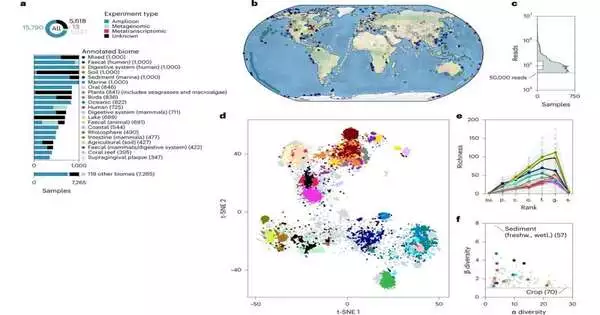A combination of environmental elements, including temperature, moisture, and nutrient content, determines the habitat—the ecological niche—of a microorganism. However, it is challenging to determine exactly how much each of these factors will contribute. By identifying the microorganisms that coexist, a German-Dutch research team has redefined microbial niches. Led by Prof. Bas E. Dutilh from the University of Jena and Utrecht University, the researchers used this “social niche breadth” approach to create the first “Map of the Microverse” in the most recent issue of the journal Nature Ecology and Evolution.
Microorganisms colonize nearly every place on earth, sometimes in harsh conditions, whether it’s in hot springs, the human intestine, or the deep sea. Ecologists categorize organisms as “generalists” or “specialists” based on how well they have adapted to the unique environmental conditions in these ecological niches. Generalists can function in a variety of environmental settings, but specialists can only develop in very specific environments.
“How to define microbial ecological niches in the first place is a key question for the study of such different microbial strategies,” says Prof. Bas E. Drdot Dutilh. The majority of the work done up until now has been based on arbitrary environmental factors, which makes it difficult to accurately quantify the niche.
“A key concern for the study of such diverse microbial strategies is how to characterize microbial ecological niches in the first place.”
Prof. Dr. Bas E. Dutilh.
Therefore, the bioinformatician from the Cluster of Excellence “Balance of the Microverse” at the University of Jena and researchers from Utrecht University have used a novel, data-driven method to describe microbial niches, where the species community itself is considered the key environmental factor rather than the external habitat conditions. This works because microbial communities quickly adjust to their surroundings, and as a result, their make-up reflects the totality of environmental factors.
Generalists rule the majority of microbial habitats.
Thousands of metagenomic data sets from various microbial samples collected from all over the world were analyzed and quantified by the researchers for their study. Generalists predominate in the majority of habitats, according to Dutilh’s research. The researchers were initially taken aback by this discovery because they had previously believed that specialists might predominate in regional niches because they were better suited to the unique circumstances. However, they discovered that rival generalists could expand much more quickly and take control of the niche.
“However, it’s hit-or-miss for generalists; either they succeed or fail. They are therefore quite erratic in their appearance. Specialists are more reliable in their field, despite being scarce.
The size of the generalists’ genomes was another outcome that the researchers were not prepared for. According to Dutilh, “this was previously assumed because metabolic flexibility was thought to generally require a larger genome.”. However, it turns out that there is a more nuanced relationship between niche range and genome size.
We found two opposing evolutionary strategies: In habitats with relatively low local biodiversity, like animal-associated microbiomes, the specialists have a relatively small genome. The genome of the specialists is significantly larger in habitats with a great deal of biological diversity, such as soils.”.
Genes come and go throughout evolution, making generalists’ genomes more variable than those of specialists. They are able to quickly adapt to the local niche as a result of being able to incorporate genetic information from other organisms through horizontal gene transfer. In the genomes of generalists, “we also see specific functions that are associated with horizontal gene transfer,” claims Dutilh.
The roles played by specialists are much more varied and frequently connected to very particular metabolic processes. In contrast to the genomes of generalists, those of specialists are evolutionarily stable.
Bas E. concludes, “Our study provides fresh, unexpected insight into microbial niche range strategies across the microbial tree of life.” Dutilh is certain.
More information: F. A. Bastiaan von Meijenfeldt et al, A social niche breadth score reveals niche range strategies of generalists and specialists, Nature Ecology & Evolution (2023). DOI: 10.1038/s41559-023-02027-7





